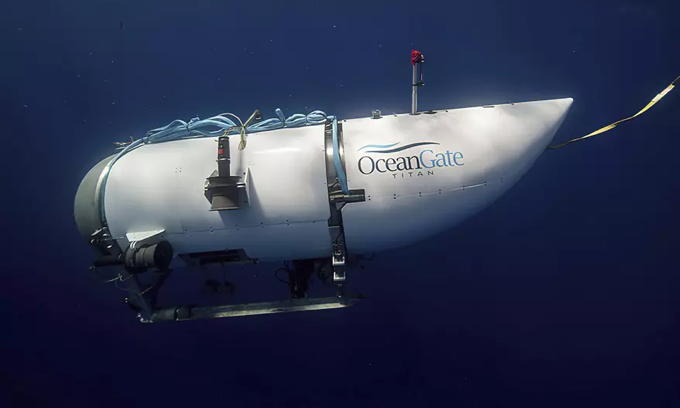The U.S. Navy detected the Titanic-bound submersible’s implosion on Sunday, days before the information was disclosed to the public on Thursday after a massive search operation that captured global attention, according to a U.S. Coast Guard (USCG) official.
The five men aboard the Titan, who were attempting to explore the Titanic wreckage in the Atlantic Ocean, are believed to have tragically perished due to a suspected “catastrophic implosion,” according to USCG officials.
In a surprising revelation, the USCG has confirmed that the U.S. Navy first detected the implosion soon after the Titan went missing on Sunday. The Navy promptly provided this information to aid the search and rescue efforts, although its significance could not be definitively determined. The Wall Street Journal first reported the news citing unnamed sources.
“As a member of the Unified Command, the U.S. Navy conducted an analysis of acoustic data and detected an anomaly consistent with an implosion or explosion in the general vicinity of where the Titan submersible was operating when communications were lost,” USCG spokesperson Petty Officer 3rd Class Briana Carter said in a statement.
“While not definitive, this information was immediately shared with the Incident Commander to assist with the search and rescue mission.”
During a press briefing held at 3 p.m. on Thursday, Coast Guard Rear Adm. John W. Mauger revealed that a debris field, presumably belonging to the missing vessel, was discovered approximately 1,600 feet from the bow of the Titanic wreckage. He noted that this debris field indicated a “catastrophic implosion” and appeared to be “consistent with catastrophic loss of the pressure chamber” within the submersible.
Mauger expressed his condolences to the families affected by this tragic event.
“Upon this determination, we immediately notified the families,” he said. “On behalf of the United States Coast Guard and the entire unified command, I offer my deepest condolences to the families. I can only imagine what this has been like for them. And I hope that this discovery provides some solace during this difficult time.”
Race Against Time
Initially, it was estimated that the five individuals on board had approximately 96 hours’ worth of oxygen supply from the time the vessel first submerged on Sunday morning. However, considering the possibility of oxygen conservation, it remains unclear how long they may have survived.
OceanGate, the operator of the submersible vehicle, expressed profound grief in a statement released on Thursday. The company confirmed the loss of its CEO Stockton Rush, along with Shahzada Dawood, Suleman Dawood, Hamish Harding, and Paul-Henri Nargeolet, acknowledging their adventurous spirits and deep passion for exploring and preserving the world’s oceans.
“These men were true explorers who shared a distinct spirit of adventure, and a deep passion for exploring and protecting the world’s oceans,” the statement reads. “Our hearts are with these five souls and every member of their families during this tragic time.”
OceanGate expressed gratitude for the efforts of those involved in the days-long search that involved multiple organizations and countries “who expedited wide-ranging resources and have worked so very hard on this mission.” The company stated its appreciation for “their commitment to finding these five explorers, and their days and nights of tireless work in support of our crew and their families.”
“This is a very sad time for the entire explorer community, and for each of the family members of those lost at sea,” the statement reads. “We respectfully ask that the privacy of these families be respected during this most painful time.”
Rescue efforts involved a concerted mobilization of ships, planes, and sophisticated equipment, although the operation faced challenges due to changing weather conditions, ocean currents, and sea states.
A breakthrough came on Wednesday when the U.S. Coast Guard announced the successful deployment of an undersea robot by a Canadian vessel, which effectively reached the ocean floor. Additionally, a French research institute stated that a deep-diving robot with cameras, lights, and arms also joined the operation.
Authorities had been hoping that underwater sounds might help narrow their search, with a coverage area that has been expanded to thousands of miles—twice the size of Connecticut—and in waters 2.5 miles deep. Coast Guard officials said underwater noises were detected in the search area on Tuesday and Wednesday.
Jack Phillips contributed to this report.



















Our Air Force has to be told of Chinese Spy balloons by an astute citizen after already penetrating our security airspace, while the Navy detects a sub implosion with expensive high-tech equipment that could detect a fart in a factory, but nobody can figure out what is going on in real time? Sounds like many of our military leaders are of the same kind being clone cranked out of our government over-subsidized American educational system. The wrong people are getting the educations and we are WOKE wasting money educating people far beyond their innate mental ability to process the information, or else they are on the same drugs Hunter was on when he got kicked out of the military after proving he is the smartest guy Joe knows,,,,now like our same mis-chosen failing military under Joe’s control that are beginning to fail just like all the other liberal degreed political apparatchik depart heads Joe put in charge of the rest of the government that already proved how well they are equipped to fail. Militarily this is a recipe for total defeat when cutting corners to please rich people end up with unqualified, poorly built equipment imploding like a Putin on the battlefield, or a Sub on a joy ride to Davy Jones Locker by rich men who want to buy, not earn their 15 seconds of a DeCaprio “I’m King of the World” moment that leads to becoming fish food like “I’m Chicken of the Sea.”